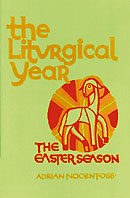
"After inquiries of my own among the young, the faithful of all ages, and priests and religious, and after careful inquiry on the part of the publisher, it became clear that the treasures contained in the new lectionary will be a source of confusion rather than a help unless they are presented in a simple straightforward way. To many, the connection between the various readings and other elements of a celebration is not always clear, nor is the broad overall theme of a liturgical season. More importantly, many do not see these celebrations as being in any way relevant to their life in the modern world. There seemed to be room, then, for a simple presentation of the liturgical year as envisaged in the reform which Vatican Council II initiated; in such a presentation I would try to meet the needs expressed to me in various pastoral circles.
"My purpose explains the threefold division of each volume. First some biblico-liturgical reflections on the particular phase of the liturgical year. Has this celebration, connected as it is with the history of salvation, anything to do with us today?
"Next I take up the structure and themes of the season. How are the readings and celebrations of the season organized? How are we to read the Scripture texts that the liturgy inserts into a specific context?
"Finally there are suggestions from the past. In order to widen our field of vision and to supply material for celebrations of the word, may we not draw upon the local churches of the past and share their experience of the liturgical seasons as these gradually took shape in the life of these churches?
"These volumes make no claim to be complete. Their aim is simply to offer lines of thought and subjects for reflection to the faithful and their pastors, to those in charge of various groups, and above all, to those who wish to experience the Church's liturgy more fully. At no point have I felt I was being unfaithful to scientific standards or to a method that should never be set aside, even in pastoral work. My work is intended to be readable, but as the notes will suggest at times, it is also based on strict scholarly principles without which any work, even if it be pastoral or 'spiritual,' will lack objectivity and solidity.
"I have not thought it advisable to supply a bibliography. The reformed liturgical year has not yet been studied as a whole. There do exist collections providing essays on each Sunday or feast; but these are well known and will be of help to any who wish to undergird their celebrations with a more profound liturgical and spiritual theology. There are also a good many articles on the new lectionary and its composition, good points, and limitations, but citation of these would be out of place in a work that does not aim to give the reader a complete inventory of studies done on the new liturgy or to guide him in future study of his own. This work, like every other, must be faithful to its own purpose and corresponding structure.
"My desire is to serve as many as I can of those faithful who wish to experience the greatest treasure and most vital stimulus the Church has to offer them: the presence of the Lord in her word and her Eucharist." - Adrian Nocent, O.S.B. (from the Preface)
Follows a three-part pattern: 1) biblical and liturgical reflections on the season; 2) the season's structure and themes; 3) suggestions from the past.
Now sold only as a set of four volumes since individual books are no longer available from the publisher. The four volumes cover the entire liturgical year for the complete cycle of three years.
"By the way, if you can find Nocent's four volumes anywhere it's a great find. It is geared to the RC lectionary, but the RCL kept 90% of the RC choices, and is full of wonderful historical information, especially for liturgical churches." Joseph McCaffrey, jmccaffrey@ADELPHIA.NET
This item does not qualify for free shipping. However, normal shipping applies and there is never a surcharge.